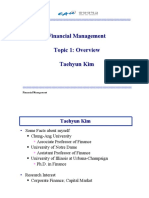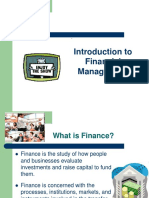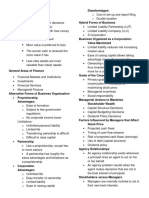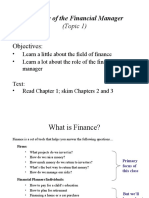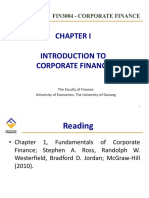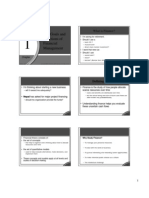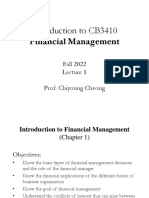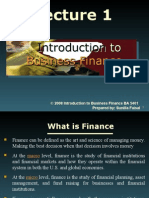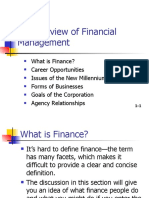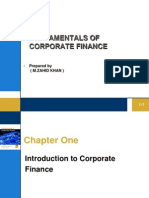FIN 502 Business Finance
Lecture 1: Introduction
Professor Ran Duchin
Foster School of Business
1
� Basic Information
Ran Duchin
Office: 573 Paccar Hall;
Email: duchin@uw.edu
Phone: 543-4377
All course materials will be made available on Canvas
Lectures will focus on key concepts, with applications & examples
You are responsible for digital or hard copies of the lecture slides (Canvas)
Textbook: “Corporate Finance: The Core” by Berk and DeMarzo,
4th edition
Good coverage of key concepts; Used in some elective finance classes
We will use a financial calculator & Excel
I will use the TI BA II Plus calculator in class
2
� Basic Information - Continued
Homework available on Canvas
Individual and team assignments
Three cases done in teams
Ocean Carriers and Flash Memory, Inc. included in the course pack.
It can be purchased from Harvard Publishing at:
https://hbsp.harvard.edu/import/684031
The Stock Market Case
Syllabus has grading policy
Midterm exam -- 30%
Final exam -- 30%
Homework assignments -- 16%
Cases -- 24%
3
� The Stock Market Case
Pick a portfolio of 4 stocks in which to invest a total of $100,000
Goal: earn the largest returns
Up to $40,000 in any one stock
Work in study teams
Next Monday (January 13th)
Summary with stock picks: name and ticker symbol, amount, reason
You will buy the shares at the close of trading on Friday, January 17th
Enter information at http://faculty.washington.edu/duchin/stockdata.html
Beginning Friday (January 24th)
Enter new portfolio value every Friday after close of trading
Liquidation date is Friday, March 6th
Summary of performance and events on Wednesday, March 11th 4
4
� Financial Decisions Made by Individuals
Personal Income
Savings
Consumption
(Investments)
Investment Horizon Risk Expected Return
5
� Consumption vs. Savings
Personal Savings Rate in the U.S.
6
� Financial Decisions Made by
Individuals: Examples
What part of income to set aside as savings?
Retirement planning (e.g. 401K)
Meeting future financial goals (e.g. children’s education)
How to invest savings?
Asset allocation: what asset classes? (e.g. stocks vs. bonds)
Security selection: which particular stocks or bonds?
This course
Valuing bonds and stocks
Assessing the risk of financial assets
Introduction to modern portfolio theory
7
� Financial Decisions Made by
Corporations
Basic
Business
Decisions
Investment: Financing: Managing Cash Flow:
What projects should How should the firm How should the firm
the firm invest in? finance its projects? manage its cash flow?
Debt Equity
8
� The Capital Budgeting Decision
Current
Liabilities
Current Assets
Long-Term
Debt
Fixed Assets
What long-term
1 Tangible investments Shareholders’
should the firm
2 Intangible Equity
choose?
9
9
� The Capital Structure Decision
Current
Liabilities
Current Assets
Long-Term
How should the Debt
firm raise funds
for the selected
Fixed Assets
investments?
1 Tangible
Shareholders’
2 Intangible Equity
10
10
10
� Short-Term Asset Management
Current
Liabilities
Current Assets Net
Working Long-Term
Capital Debt
How should
Fixed Assets
short-term assets
1 Tangible be managed and
financed? Shareholders’
2 Intangible Equity
11
11
11
� Financial Decisions Made by
Corporations: Examples
In what projects should the company invest?
Apple announces the iPad Mini as competition rose from 7" devices
such as the Kindle Fire HD and Nexus 7 (2012)
Where to get the funding for the company’s
investments?
IPO: Alibaba (2014, $25 billion); Facebook (2012, $16 billion)
Bond issue: Apple (2013, $17 billion)
How to manage cash flow?
Microsoft (2003) and Apple (2012) start paying dividends
General Electric, U.S. Bancorp, and Wells Fargo cut dividends
(2009)
12
12
12
� Why Should I Care about Finance?
“I don’t want to be a financial manager.”
Suppose you’re in marketing; you need finance to:
Decide whether an ad campaign is worth the cost;
Determine the value of a brand
If you’re in IS, you’ll need finance to:
Decide whether your company should invest in new managerial software
Decide whether to invest in a new, faster server
If you’re in accounting:
Investors and lenders will use the financial statements you put together to
conduct financial analyses
Knowing how your numbers are used will make you a better accountant
Any time your company needs to spend money on something to help it make money
in the future, you will need to use finance to determine whether it is worth it!
13
13
13
� What is a Corporation?
A corporation is a legal form of business organization
characterized by:
(1) Limited liability
Owners‘ personal wealth is shielded from the obligations of
the corporation
(2) Separation of ownership from the management
“You do not have to know everything we do to profit from it”
(United Technologies marketing campaign, 2008)
(3) Right to issue financial securities
Access to capital markets
14
14
14
� Stakeholders of a Corporation
Society
Government
(Taxation)
Employees
(HR)
Investors
Suppliers (Finance)
Corporation
(Operations)
Competitors
(Strategy) Customers
(Marketing)
15
15
15
� Pros and Cons of the Corporate
Form of Business
Advantages Disadvantages
Limited liability Conflict of interest between
Unlimited life
management and owners
(i.e. agency problems)
Use of management
Double taxation:
expertise
Income taxed at the
Easy transfer of
ownership corporate rate
Dividends taxed at the
Access to capital markets
personal rate
16
16
16
� The Goal of Financial Management
What is the correct goal?
Survive
Avoid financial distress and bankruptcy
Beat the competition
Maximize sales or market share
Maximize profit
Minimize risk
Minimize costs
Maximize current value per share of existing
stock
17
17
17
� The Agency Problem
Agency relationship
Principal hires an agent to represent his/her interest
Stockholders (principals) hire managers (agents) to run the
company
Agency problem
Conflict of interest between principal and agent
management may make decisions that benefit their self-interest
rather than those of the stockholders
18
18
18
� Managerial Goals
Managerial goals may be different from shareholder
goals
Expensive perquisites
Survival
Control or “Empire-Building”
Agency costs: The costs of the conflict of interest
between the firm’s owners and its management
Direct costs
Indirect costs
19
19
19
� Managing Managers
Managerial compensation
Incentives can be used to align management and stockholder
interests
The incentives need to be structured carefully to make sure that
they achieve their intended goal
Corporate control
The threat of a takeover may result in better management
20
20
20
� Financial Markets
Financial Market is a mechanism that facilitates the
transfer of capital between investors and
corporations
Institutions that support financial markets:
Stock exchanges
Brokerage houses
Investment banks
Regulatory bodies
21
21
21
� Financial Markets
Financial
Markets Individual
Corporation Investors
capital acquisition of issued stocks/bonds savings
earnings dividends/interest, consumption
share repurchases
reinvestment
22
22
22
� Role of Financial Markets
Facilitate allocation of capital
Transfer resources from investors to corporations
Disseminate information via prices
When asset prices fully reflect public information, financial markets are
considered efficient
Improve allocation of risk
Opportunities for risk sharing and hedging
Facilitate consumption smoothing across time
Invest now to consume in the future
Separate owners from managers
Facilitate deployment of managerial expertise in running companies
23
23
23
� Assets Traded in Financial Markets
Main types of financial assets traded in
financial markets:
Bond (debt): firm’s obligation to repay the principal and interest at
pre-specified dates in the future
Essentially, a loan from an investor to a corporation
Stock (equity): investor’s share of ownership in a corporation
The right to share in a firm’s cash flow after senior obligations
(e.g. taxes, interest, etc.) have been met
Derivative (option, future, forward, and swap): asset whose payoff
is determined by (derived from) the price of another asset
We will briefly introduce options
Mostly studied in elective courses 24
24
24
� Comparing Bonds and Stocks
Stocks Bonds
Payment (dividend) is uncertain Payment is fixed
More risky Less risky
Right of ownership Loan
Infinite life Finite life (expires at maturity)
Dividends are paid from after-tax Interest is a tax-deductable
profit expense
25
25
25
� Historical Performance of Stocks and Bonds
*adjusted for inflation
26
26
26
� Stocks vs. Bonds as an Investment
"The upward movement of stock values over time overwhelms the
short-term fluctuations in the market. There is no compelling reason
for long-term investors to significantly reduce their stock holdings,
no matter how high the market seems."
Jeremy Siegel, author of Stocks for the Long Run
(one of the 10 best investment books of all time by the Washington Post)
Why invest in bonds at all?
27
27
27
� Range of Annual Returns of Stocks & Bonds
Source: Granite Research
28
28
28
� Building Intuition: Asset Pricing
Evaluate the following argument:
“Russian stocks are too risky for any prudent
investor. There is no market for such securities”
How does the market induce investors to buy high-
risk stocks when low-risk stocks are available?
29
29
29
� Summary
Corporation
Limited liability and separation of ownership and
management
Easier access to capital markets
Financial markets
Facilitate capital transfer from investors to corporations
Disseminate information via prices
Next:
1. Review TVM tools
2. Discuss interest rates and inflation
3. Use TVM tools to evaluate securities (bonds and stocks)
and investment projects
30
30
30
